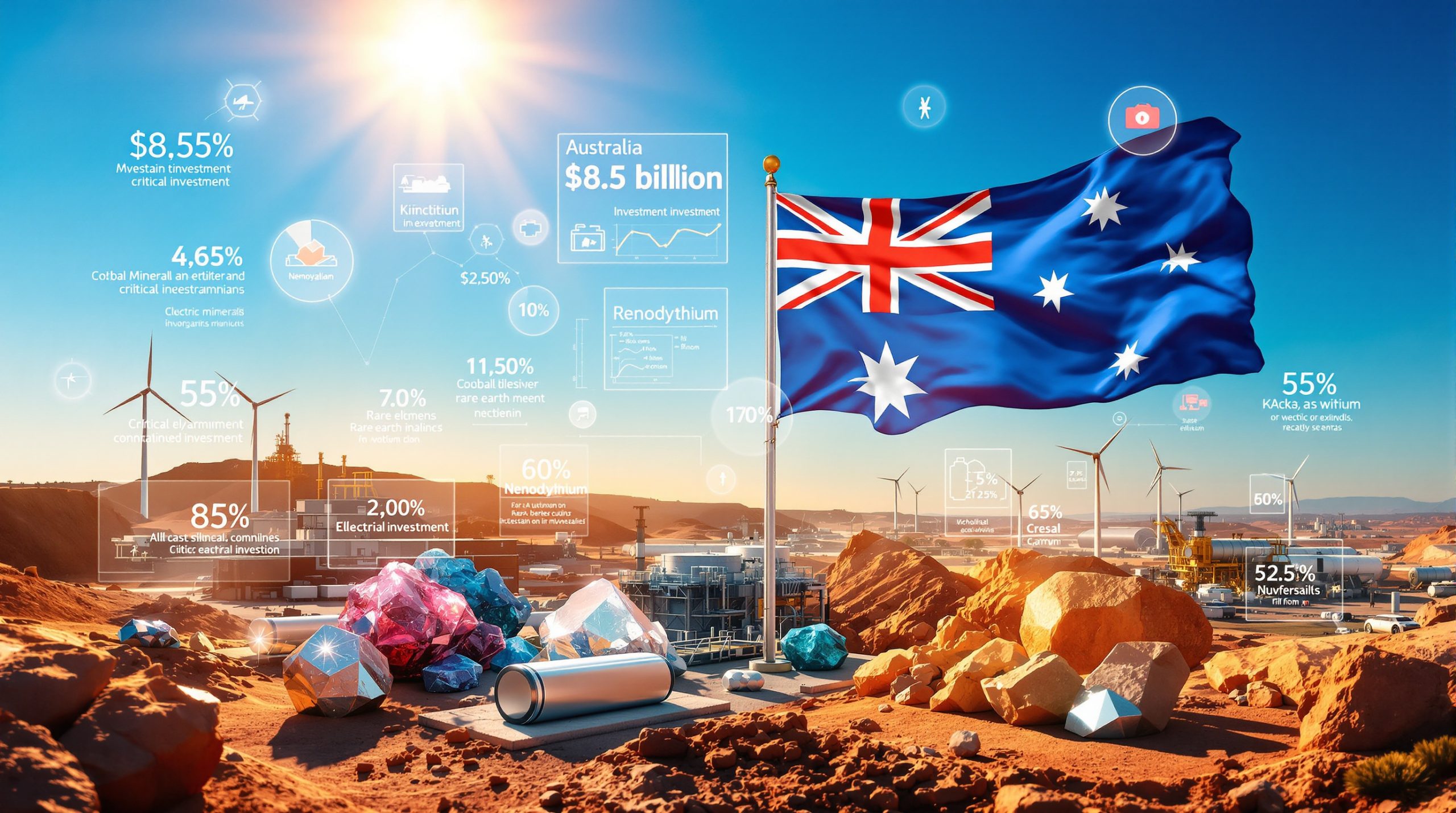What is the Critical Minerals Strategic Reserve Plan?
The Critical Minerals Strategic Reserve is a proposed federal government initiative announced by Prime Minister Anthony Albanese that would grant the government authority to purchase, own, and sell critical minerals found in Australia. The plan represents a significant shift in how Australia manages its valuable mineral resources, positioning the government as an active participant in critical minerals markets rather than just a regulator.
If re-elected, Albanese’s government would establish a dedicated taskforce to consult with industry stakeholders and finalize the scope and design of the reserve. According to the current timeline, the reserve would become operational from the second half of 2026, allowing time for thorough consultation and implementation planning.
Key Features of the Proposed Reserve
The strategic reserve would enable government participation in critical minerals markets through several mechanisms:
- Federal authority to directly purchase, own, and sell Australian critical minerals
- Design focused on protecting Australia’s national interest and resource sovereignty
- Voluntary offtake agreements for producers seeking revenue stability
- Implementation timeline beginning in the second half of 2026
- Establishment of a specialized taskforce for consultation and design finalization
Prime Minister Albanese has described the initiative as “a national asset” that the government would leverage to “advance Australia’s national interest,” highlighting the strategic importance of critical minerals to Australia’s economic and national security future.
Why is Australia Focusing on Critical Minerals?
Australia’s renewed focus on critical minerals stems from its unique position in global resource markets and growing recognition of these materials’ strategic importance in the global transition to clean energy and advanced technologies.
Australia’s Strategic Position in Global Critical Minerals
Despite holding the world’s third-largest known rare earth reserves, Australia currently accounts for only 3% of global rare earths production – a significant disconnect between potential and actual output. This disparity represents both a challenge and an opportunity for Australia’s resources sector.
The nation is strategically positioned to capitalize on growing trade tensions and geopolitical disruptions affecting global supply chains, particularly given China’s dominance in critical minerals processing. Australia’s democratic institutions and reliable legal framework make it an attractive alternative supplier for Western nations seeking to reduce dependence on China export restrictions.
The proposed reserve could also help limit the impact of US tariffs through strategic inventory management, allowing Australia to navigate trade disputes from a position of strength rather than vulnerability.
Market Challenges for Critical Minerals
According to Rebecca Tomkinson, Chief Executive of Western Australia’s Chamber of Minerals and Energy, “Markets for rare earths are thin, opaque, and subject to unpredictable price swings.” This volatility creates significant barriers to investment in new projects, as financiers struggle to forecast returns in such uncertain market conditions.
The difficulty in getting projects off the ground due to market volatility has been a persistent challenge for Australia’s critical minerals sector. Many promising deposits remain undeveloped due to financing obstacles, despite growing global demand for these materials.
Downward pressure on commodity prices has affected the commercial viability of several Australian projects, with some operations struggling to maintain profitability amid price fluctuations. This volatility particularly impacts junior miners with limited capital reserves to weather market downturns.
How Has the Mining Industry Responded?
The industry response to the Labor Party’s proposal has been notably divided, with major industry organizations taking contrasting positions on the initiative’s potential benefits and drawbacks.
Minerals Council of Australia’s Concerns
The Minerals Council of Australia (MCA) has expressed significant reservations about the strategic reserve proposal. MCA Chief Executive Tania Constable has questioned “whether a strategic reserve is the best approach” for supporting the critical minerals sector, citing uncertainty about domestic risks to commercial operations.
“The objective and merits of a Critical Minerals Strategic Reserve remain unclear and this initiative must be evaluated against other opportunities to leverage our mining industry,” Constable stated, highlighting the industry peak body’s preference for alternative support mechanisms that focus on fundamental industry needs rather than direct government market intervention.
The MCA’s concerns center on potential market distortions that could arise from government participation in mineral purchasing and sales, particularly if such activities influence pricing mechanisms or create uncertainty for private investors.
Western Australia’s Chamber of Minerals and Energy Support
In contrast to the MCA’s position, Western Australia’s Chamber of Minerals and Energy has offered qualified support for the strategic reserve concept. The Chamber has recognized the importance of WA’s critical minerals deposits to Australia’s economic future and acknowledged the opportunity to attract significant investment to the sector.
Rebecca Tomkinson, the Chamber’s Chief Executive, stated: “Federal Labor’s plan to offer voluntary offtake agreements that allow producers to lock in stable and predictable revenue may assist in bringing projects to market by enhancing their attractiveness to investors.” This endorsement highlights the potential for the reserve to address market volatility issues that currently hinder project development.
The Chamber has emphasized that any offtake agreements must include fair pricing reflective of Australia’s high environmental, social, and governance (ESG) standards, ensuring that producers are not disadvantaged by government purchasing arrangements.
What Alternative Approaches Does the Industry Suggest?
Industry stakeholders have proposed several alternative approaches to supporting Australia’s critical minerals sector that they believe may deliver more effective outcomes than a strategic reserve.
Focus on Fundamental Industry Support
The Minerals Council of Australia has advocated for strengthening the Junior Minerals Exploration Incentive, which they project could generate $725 million in greenfield exploration over ten years. This approach focuses on stimulating discovery and development of new deposits rather than intervening in existing markets.
Other fundamental industry supports suggested by the MCA include:
- Lower energy prices for mining operations to improve international competitiveness
- Wind-back of industrial relations laws that increase operational costs
- Faster environmental approval times to reduce project delays and financing costs
- Streamlined regulatory frameworks that maintain standards while reducing compliance burdens
These measures aim to address structural challenges facing the industry rather than symptoms of market volatility.
Enhanced Project Investment Attractiveness
Industry leaders have also suggested approaches to enhance project investment attractiveness without direct government market participation:
- Ensuring fair pricing mechanisms in any government involvement with the sector
- Promoting recognition of Australia’s high ESG standards in international markets
- Addressing mineral shortages through targeted financial instruments and risk-sharing mechanisms
- Creating favorable conditions to unlock Australia’s critical minerals potential through targeted infrastructure investment
These approaches focus on leveraging Australia’s existing advantages in the global commodities insights while addressing specific barriers to critical minerals development.
How Would the Strategic Reserve Benefit Australia?
Proponents of the strategic reserve highlight several potential benefits for Australia’s national interests and economic development.
National Security and Trade Advantages
The strategic reserve would potentially position Australia to deal with trade disruptions from a position of strength, allowing the government to manage supply during periods of market instability or geopolitical tension.
With access to internationally significant quantities of in-demand resources, Australia could strengthen its strategic relationships with key allies who depend on critical minerals for defense and clean energy technologies.
The development of a national asset to advance Australia’s interests could provide leverage in international negotiations and trade agreements, particularly in an era of increasing resource nationalism globally.
Furthermore, the strategic reserve could strengthen Australia’s position in global supply chains by ensuring continuity of supply and demonstrating resource reliability to international partners.
Economic Development Opportunities
By bringing more critical minerals projects to market through reduced investment risk, the strategic reserve could accelerate development of Australia’s resources sector beyond traditional commodities.
The proposal aims to enhance project attractiveness to investors by providing revenue certainty through offtake agreements, potentially unlocking capital for projects that would otherwise struggle to secure financing.
Regional development and job creation would likely follow expanded mining operations, particularly in remote areas of Western Australia and the Northern Territory where many critical minerals deposits are located.
The initiative could ultimately help unlock Australia’s world-class critical minerals endowment, transforming potential resources into productive assets generating export income and tax revenue. Federal grants have already been implemented to push Australia toward critical minerals leadership on the global stage.
FAQ About the Critical Minerals Strategic Reserve
What critical minerals would be included in the reserve?
While specific minerals have not been detailed in the proposal, likely candidates include rare earth elements, lithium, cobalt, graphite, and other minerals essential for renewable energy technologies and defense applications. The final selection would presumably be determined following the taskforce consultation process.
How would the reserve affect current mining operations?
The reserve could provide stability through voluntary offtake agreements but may also impact commodity prices in ways that concern some industry participants. Industry leaders have expressed particular concern about potential downward pressure on prices affecting commercial viability of existing operations and planned investments.
What is the timeline for implementation?
If the Labor government is re-elected, the reserve would become operational from the second half of 2026, following an extensive consultation period with a dedicated taskforce comprised of industry, government, and technical experts.
How does this compare to similar initiatives globally?
Several countries including the United States, Japan, and European nations have implemented strategic reserves for critical materials, though Australia’s approach would be tailored to its position as a major resource producer rather than primarily a consumer. Investors are increasingly looking for geopolitical market strategies to navigate these complex developments in the global minerals sector.
Disclaimer: This article presents analysis of a proposed government policy that has not yet been implemented. The economic impacts, investment outcomes, and industry responses outlined are based on available information and stakeholder statements, but actual outcomes may differ following implementation. Readers should consult multiple sources when forming opinions on this topic.
Searching for the Next Major Australian Mineral Discovery?
Discover how significant mineral finds can generate exceptional market returns by exploring Discovery Alert’s dedicated discoveries page, where you can see historic examples and learn how their proprietary Discovery IQ model delivers real-time alerts on ASX mineral discoveries, giving you an invaluable edge in the critical minerals market. Visit https://discoveryalert.com.au/discoveries/ to begin your 30-day free trial today.




